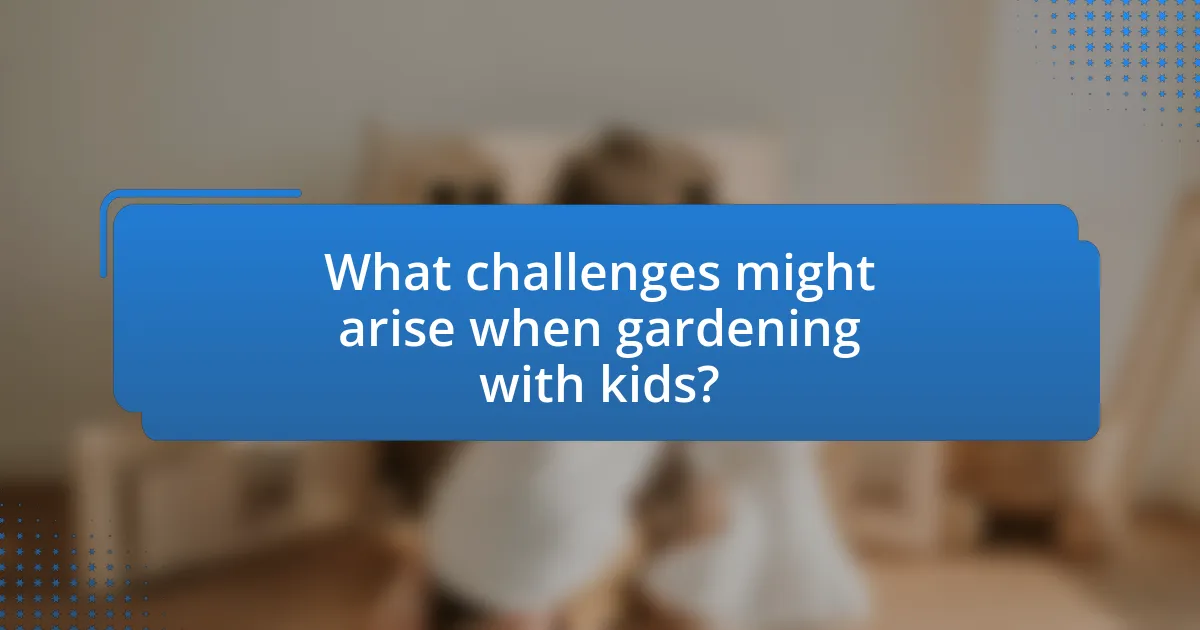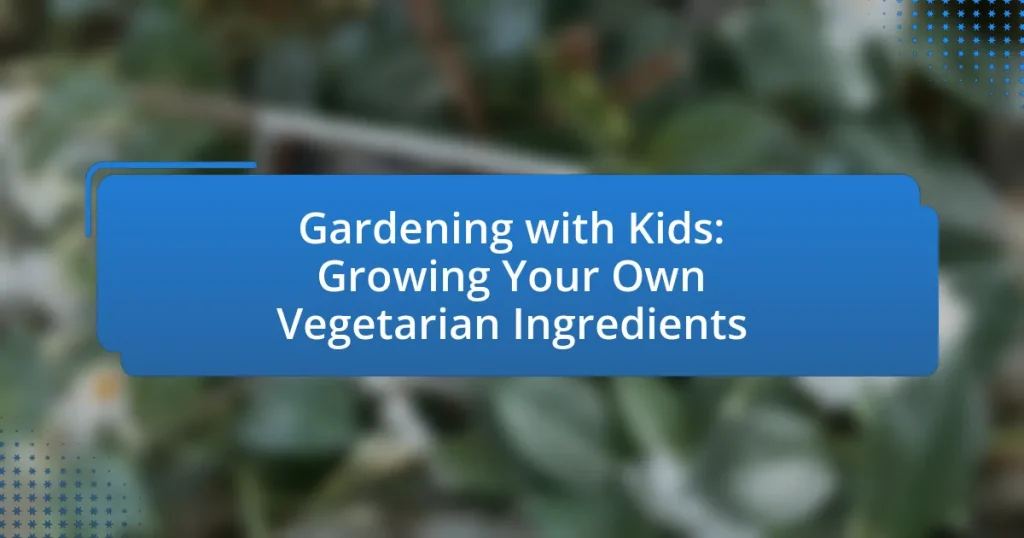Gardening with kids focuses on engaging children in the process of planting, nurturing, and harvesting their own vegetarian ingredients, which promotes healthy eating habits and enhances their understanding of science and nature. This article explores the benefits of gardening for children, including skill development in responsibility, teamwork, and problem-solving, as well as fostering a connection to nature. It also discusses the nutritional advantages of homegrown vegetables, best practices for gardening with kids, and strategies to keep children engaged in gardening activities. Additionally, the article addresses common challenges and offers practical tips for successful gardening experiences that can enhance family bonding and promote healthier dietary choices.

What is Gardening with Kids: Growing Your Own Vegetarian Ingredients?
Gardening with kids involves engaging children in the process of planting, nurturing, and harvesting their own vegetarian ingredients. This activity not only teaches children about the growth cycles of plants but also promotes healthy eating habits by encouraging them to consume fresh vegetables they have grown themselves. Research indicates that children who participate in gardening are more likely to try new fruits and vegetables, enhancing their nutritional intake. Additionally, studies show that gardening can improve children’s understanding of science and nature, fostering a sense of responsibility and teamwork.
How can gardening be a fun activity for children?
Gardening can be a fun activity for children by engaging them in hands-on learning and fostering creativity. Children enjoy planting seeds, watching them grow, and taking care of plants, which provides a sense of accomplishment. Research shows that gardening activities can enhance children’s understanding of biology and ecology, as they learn about plant life cycles and the environment. Additionally, gardening encourages physical activity and can improve fine motor skills through tasks like digging, planting, and watering. Studies indicate that children who participate in gardening are more likely to try new vegetables, promoting healthier eating habits.
What skills do children develop through gardening?
Children develop various skills through gardening, including responsibility, patience, teamwork, and problem-solving. Engaging in gardening tasks requires children to take care of plants, which fosters a sense of responsibility as they learn to nurture living things. The process of waiting for seeds to grow teaches patience, as plants take time to develop. Additionally, gardening often involves collaboration with peers or family members, enhancing teamwork skills. Finally, children encounter challenges such as pests or weather changes, which encourages problem-solving as they find solutions to these issues. These skills are supported by studies indicating that gardening activities can significantly enhance children’s social and cognitive development.
How does gardening foster a connection to nature for kids?
Gardening fosters a connection to nature for kids by engaging them in hands-on activities that promote observation and interaction with the environment. When children plant seeds, water plants, and observe growth cycles, they develop an understanding of ecosystems and the importance of biodiversity. Research indicates that children who participate in gardening activities show increased awareness of environmental issues and a greater appreciation for nature. For instance, a study published in the Journal of Environmental Education found that children involved in school gardening programs exhibited improved attitudes towards the environment and enhanced knowledge about plant life. This direct involvement in gardening cultivates a sense of responsibility and stewardship towards nature, reinforcing their connection to the natural world.
Why is growing vegetarian ingredients important for families?
Growing vegetarian ingredients is important for families because it promotes healthier eating habits and fosters a connection to food sources. Families that cultivate their own vegetables and fruits are more likely to consume a diet rich in nutrients, as homegrown produce is often fresher and free from harmful pesticides. Research indicates that children who participate in gardening activities are more inclined to try new vegetables and develop a preference for healthy foods, leading to better overall nutrition. Additionally, growing vegetarian ingredients can enhance family bonding through shared activities and teach children valuable life skills, such as responsibility and patience.
What are the nutritional benefits of homegrown vegetables?
Homegrown vegetables provide numerous nutritional benefits, including higher nutrient density, better flavor, and reduced exposure to pesticides. Research indicates that homegrown produce often contains more vitamins and minerals compared to store-bought options, as they can be harvested at peak ripeness, maximizing their nutritional content. For example, a study published in the Journal of Agricultural and Food Chemistry found that homegrown tomatoes had significantly higher levels of vitamin C and antioxidants than commercially grown varieties. Additionally, growing vegetables at home encourages healthier eating habits, as children involved in gardening are more likely to consume a variety of vegetables, leading to a more balanced diet.
How does growing your own food promote healthy eating habits?
Growing your own food promotes healthy eating habits by increasing access to fresh, nutrient-dense produce. When individuals cultivate their own vegetables and fruits, they are more likely to consume these healthier options regularly, leading to improved dietary choices. Research indicates that children who participate in gardening activities are more inclined to eat fruits and vegetables, with a study published in the Journal of Nutrition Education and Behavior showing that gardening can increase children’s fruit and vegetable intake by up to 50%. This hands-on experience not only fosters a preference for healthier foods but also enhances knowledge about nutrition and food sources, reinforcing positive eating behaviors.

What are the best practices for gardening with kids?
The best practices for gardening with kids include selecting easy-to-grow plants, involving them in all gardening tasks, and making the experience fun and educational. Easy-to-grow plants like radishes, sunflowers, and beans can provide quick results, keeping children engaged. Involving kids in tasks such as planting, watering, and harvesting fosters responsibility and teamwork. Additionally, incorporating educational elements, such as teaching them about plant life cycles and the importance of pollinators, enhances their learning experience. Research indicates that hands-on gardening activities can improve children’s understanding of nutrition and environmental stewardship, making it a valuable educational tool.
How can you choose the right plants for children to grow?
To choose the right plants for children to grow, select easy-to-care-for, fast-growing varieties such as radishes, beans, or sunflowers. These plants are suitable because they require minimal maintenance and provide quick results, which keeps children engaged and motivated. Research indicates that children benefit from hands-on gardening experiences, as it enhances their understanding of biology and responsibility (American Horticultural Society). Additionally, plants like herbs (e.g., basil or mint) can be chosen for their culinary uses, allowing children to connect gardening with cooking, further enriching their learning experience.
What are some easy-to-grow vegetarian ingredients for kids?
Some easy-to-grow vegetarian ingredients for kids include radishes, lettuce, and cherry tomatoes. Radishes germinate quickly, often within 5 to 10 days, making them a rewarding choice for children. Lettuce is also simple to cultivate, with a short growing cycle of about 30 days from seed to harvest, allowing kids to see results quickly. Cherry tomatoes are another excellent option; they thrive in containers and can produce fruit in approximately 60 to 80 days, providing a fun and tasty reward for young gardeners. These ingredients are not only easy to grow but also encourage children to engage with gardening and healthy eating.
How do seasonal changes affect plant selection?
Seasonal changes significantly influence plant selection by determining which species thrive in specific climatic conditions. For instance, cool-season crops like spinach and peas are best planted in early spring or fall, while warm-season crops such as tomatoes and peppers flourish in summer. The USDA Plant Hardiness Zone Map provides a framework for understanding which plants can survive in various temperature ranges, guiding gardeners in selecting appropriate species for their local climate. Additionally, seasonal variations in daylight and rainfall affect growth rates and flowering times, further impacting plant selection.
What tools and resources are helpful for gardening with kids?
Gardening with kids can be enhanced by using child-sized gardening tools, such as small shovels, rakes, and watering cans, which are designed for their hands and strength. Additionally, resources like gardening books tailored for children, educational websites, and interactive gardening apps can provide guidance and inspiration. Studies show that engaging children in gardening activities fosters responsibility and a connection to nature, making these tools and resources effective in promoting a positive gardening experience.
What gardening tools are safe and suitable for children?
Gardening tools that are safe and suitable for children include lightweight hand tools such as trowels, small rakes, and watering cans designed specifically for kids. These tools are typically made from durable plastic or lightweight metal, minimizing the risk of injury. For example, tools with rounded edges and ergonomic handles are easier for children to grip and use effectively. Additionally, child-sized gloves can protect their hands while allowing them to engage in gardening activities safely. Research indicates that involving children in gardening with appropriate tools fosters responsibility and enhances their understanding of nature.
How can educational resources enhance the gardening experience?
Educational resources can enhance the gardening experience by providing essential knowledge and skills that improve plant care and cultivation techniques. For instance, instructional guides and videos can teach children about soil health, plant biology, and seasonal planting schedules, which are crucial for successful gardening. Research indicates that children who engage with educational gardening resources show increased interest in science and environmental stewardship, as evidenced by a study published in the Journal of Environmental Education, which found that hands-on gardening activities significantly boost children’s understanding of ecological concepts. Thus, educational resources not only facilitate practical gardening skills but also foster a deeper appreciation for nature among young gardeners.

What challenges might arise when gardening with kids?
Gardening with kids can present several challenges, including maintaining their attention, ensuring safety, and managing expectations. Children may struggle to stay focused on gardening tasks, leading to incomplete projects or frustration. Safety is a concern, as kids may not be aware of potential hazards like sharp tools or toxic plants. Additionally, children often have high expectations for immediate results, which can lead to disappointment when plants take time to grow. These challenges require careful planning and supervision to create a positive gardening experience.
How can you address common gardening challenges?
To address common gardening challenges, implement strategies such as selecting the right plants for your climate, ensuring proper soil health, and maintaining consistent watering practices. For instance, choosing native plants can reduce pest issues and increase resilience, as they are adapted to local conditions. Additionally, testing soil pH and nutrient levels can inform necessary amendments, promoting healthy plant growth. Regularly monitoring moisture levels and using mulch can help retain soil moisture and suppress weeds, which are common challenges in gardening. These methods are supported by research indicating that proper plant selection and soil management significantly enhance gardening success rates.
What pests should you be aware of when gardening with children?
When gardening with children, you should be aware of common pests such as aphids, caterpillars, and slugs. Aphids can damage young plants by sucking their sap, which can stunt growth and lead to disease. Caterpillars, particularly from species like the cabbage worm, can consume leaves rapidly, affecting plant health. Slugs are known to create holes in leaves and can be particularly problematic in damp conditions. These pests pose risks not only to the plants but also to children’s safety, as some may cause allergic reactions or irritation. Awareness and management of these pests are essential for a safe and productive gardening experience with children.
How can weather conditions impact your gardening efforts?
Weather conditions significantly impact gardening efforts by influencing plant growth, soil health, and pest activity. For instance, excessive rainfall can lead to waterlogged soil, which hinders root development and may cause root rot, while insufficient rainfall can result in drought stress, affecting plant vitality. Temperature extremes also play a crucial role; high temperatures can accelerate evaporation and stress plants, while frost can damage or kill tender seedlings. Additionally, humidity levels can affect the prevalence of pests and diseases, as certain insects thrive in warm, moist conditions. According to the USDA Plant Hardiness Zone Map, understanding local climate conditions helps gardeners select appropriate plant varieties that can withstand specific weather patterns, thereby enhancing gardening success.
What strategies can help keep kids engaged in gardening?
To keep kids engaged in gardening, incorporating hands-on activities and interactive learning experiences is essential. Engaging children through fun tasks such as planting seeds, watering plants, and harvesting vegetables fosters a sense of ownership and responsibility. Research indicates that children are more likely to stay interested in gardening when they can see the results of their efforts, such as watching seeds sprout and grow into edible plants. Additionally, integrating educational elements, like teaching them about plant biology or the importance of pollinators, can enhance their understanding and appreciation of gardening. Studies show that children who participate in gardening activities develop better environmental awareness and healthier eating habits, reinforcing the value of their involvement.
How can you make gardening a rewarding experience for children?
To make gardening a rewarding experience for children, involve them in hands-on activities that foster a sense of ownership and accomplishment. Engaging children in planting seeds, watering plants, and harvesting vegetables allows them to witness the growth process, which can enhance their understanding of nature and responsibility. Research indicates that children who participate in gardening activities show increased interest in healthy eating and improved nutritional knowledge, as evidenced by a study published in the Journal of Nutrition Education and Behavior, which found that children involved in gardening were more likely to consume fruits and vegetables. By providing age-appropriate tools and creating a fun, interactive environment, children can develop a lifelong appreciation for gardening and healthy eating.
What role does creativity play in gardening activities with kids?
Creativity plays a crucial role in gardening activities with kids by enhancing their engagement and learning experiences. When children participate in creative gardening tasks, such as designing their own garden layouts or choosing unique plant varieties, they develop problem-solving skills and express their individuality. Research indicates that creative activities in gardening can improve children’s cognitive development, as they learn to make decisions and think critically about plant care and growth. For instance, a study published in the Journal of Environmental Education found that children who engaged in creative gardening projects showed increased interest in science and nature, demonstrating the positive impact of creativity on their educational outcomes.
What are some practical tips for successful gardening with kids?
To successfully garden with kids, involve them in age-appropriate tasks such as planting seeds, watering plants, and harvesting vegetables. Engaging children in these activities fosters a sense of responsibility and connection to nature. Research indicates that hands-on gardening experiences can enhance children’s understanding of biology and nutrition, making it a valuable educational tool. Additionally, choosing easy-to-grow plants like radishes or sunflowers can boost their confidence and interest in gardening, as these plants typically yield quick results.
How can you create a gardening schedule that works for families?
To create a gardening schedule that works for families, involve all family members in planning and assign specific tasks based on age and ability. This collaborative approach ensures everyone feels included and responsible. For instance, younger children can help with planting seeds, while older kids can manage watering and weeding. Establish a weekly routine that aligns with family schedules, such as gardening on weekends or during designated family time. Research indicates that structured activities foster teamwork and responsibility among children, enhancing their engagement in gardening. By setting clear expectations and rotating tasks, families can maintain a balanced workload and enjoy the gardening process together.
What are some fun gardening projects to try with children?
Some fun gardening projects to try with children include creating a vegetable garden, planting a butterfly garden, and starting a herb garden. A vegetable garden allows children to learn about growing their own food, as they can plant easy-to-grow vegetables like radishes and carrots, which typically germinate quickly, providing immediate gratification. A butterfly garden can be designed by planting flowers that attract butterflies, such as milkweed and coneflowers, teaching children about pollinators and their role in the ecosystem. Starting a herb garden with plants like basil and mint is also engaging, as children can use the herbs in cooking, linking gardening to culinary experiences. These projects not only foster a love for gardening but also provide educational opportunities about nature and sustainability.


